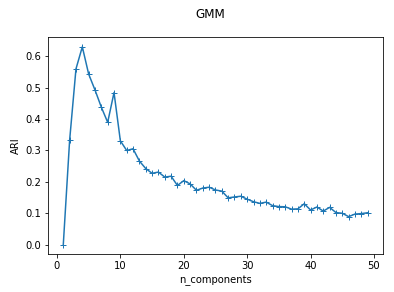import numpy as np import matplotlib.pyplot as plt from sklearn import mixture from sklearn.metrics import adjusted_rand_score from sklearn.datasets.samples_generator import make_blobs def create_data(centers,num=100,std=0.7): X, labels_true = make_blobs(n_samples=num, centers=centers, cluster_std=std) return X,labels_true #混合高斯聚类GMM模型 def test_GMM(*data): X,labels_true=data clst=mixture.GaussianMixture() clst.fit(X) predicted_labels=clst.predict(X) print("ARI:%s"% adjusted_rand_score(labels_true,predicted_labels)) # 用于产生聚类的中心点 centers=[[1,1],[2,2],[1,2],[10,20]] # 产生用于聚类的数据集 X,labels_true=create_data(centers,1000,0.5) # 调用 test_GMM 函数 test_GMM(X,labels_true)

def test_GMM_n_components(*data): ''' 测试 GMM 的聚类结果随 n_components 参数的影响 ''' X,labels_true=data nums=range(1,50) ARIs=[] for num in nums: clst=mixture.GaussianMixture(n_components=num) clst.fit(X) predicted_labels=clst.predict(X) ARIs.append(adjusted_rand_score(labels_true,predicted_labels)) ## 绘图 fig=plt.figure() ax=fig.add_subplot(1,1,1) ax.plot(nums,ARIs,marker="+") ax.set_xlabel("n_components") ax.set_ylabel("ARI") fig.suptitle("GMM") plt.show() # 调用 test_GMM_n_components 函数 test_GMM_n_components(X,labels_true)

def test_GMM_cov_type(*data): ''' 测试 GMM 的聚类结果随协方差类型的影响 ''' X,labels_true=data nums=range(1,50) cov_types=['spherical','tied','diag','full'] markers="+o*s" fig=plt.figure() ax=fig.add_subplot(1,1,1) for i ,cov_type in enumerate(cov_types): ARIs=[] for num in nums: clst=mixture.GaussianMixture(n_components=num,covariance_type=cov_type) clst.fit(X) predicted_labels=clst.predict(X) ARIs.append(adjusted_rand_score(labels_true,predicted_labels)) ax.plot(nums,ARIs,marker=markers[i],label="covariance_type:%s"%cov_type) ax.set_xlabel("n_components") ax.legend(loc="best") ax.set_ylabel("ARI") fig.suptitle("GMM") plt.show() # 调用 test_GMM_cov_type 函数 test_GMM_cov_type(X,labels_true)
